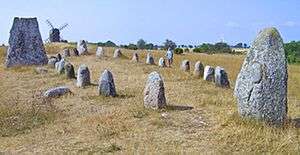Tune ship
 Tune ship at the Viking Ship Museum | |
| History | |
|---|---|
| Namesake: | Tune, Norway |
| Launched: | c. 900 |
| Status: | Museum ship |
| General characteristics | |
| Length: | 22 m (72 ft) (estimate) |
| Beam: | 4.35 m (14.3 ft) |
The Tune ship (Tuneskipet) is a Viking ship exhibited in the Viking Ship Museum (Vikingskipshuset på Bygdøy) in Bygdøy, Oslo.[1] [2][3]
The Tune ship is of the karve, a small type of longship with broad hull. It was found at the Haugen farm on the island of Rolvsøy in the parish of Tune in Østfold, Norway. It was discovered in a ship burial mound (Båthaugen, from the Old Norse word haugr meaning mound or barrow). It was discovered when the burial mound was opened and the site was excavated by archaeologist Oluf Rygh in 1867. It was named the Tune ship by Professor Rygh after excavation. This is due to the discovery being located in Tune parish.[4][5]
The Tune ship is fragmentary, but may have been up to 22 metres (72 ft) long. It is 4.35 metres (14.3 ft) wide and would have had 11 or 12 pairs of oars. The length of the keel is approximately 14 metres (46 ft). The ship was built around AD 900. It was made principally of clinkered oak planks. It is of rugged construction with naturally grown ribs, thick crossbeams and a solid gunwale.[6]
References
- ↑ Av John Johansen (20 October 2011). "Vil omdøpe Tuneskipet til "Haugenskipet"". Fredrikstad Blad. Retrieved August 15, 2016.
- ↑ "Tune". Kulturhistorisk museum (in Norwegian). Universitetet i Oslo. 10 December 2012.
- ↑ Anne-Sofie Hjemdahl. "Vikingskipshuset på Bygdøy". Store norske leksikon. Retrieved August 15, 2016.
- ↑ "The Tune ship 900 AD". Vikingskip og norske trebåter.
- ↑ Frans-Arne Stylegar. "Tuneskipet". Store norske leksikon. Retrieved August 15, 2016.
- ↑ "The Tune finds". Museum of Cultural History. University of Oslo. 10 December 2012.
| Wikimedia Commons has media related to Tune ship. |
External links
Other sources
- Marstrander, Sverre (1999) Tuneskipet (Sarpsborg: Borgarsyssel Museum) ISBN 8299266424
Coordinates: 59°16′45″N 11°00′10″E / 59.2792°N 11.0028°E
